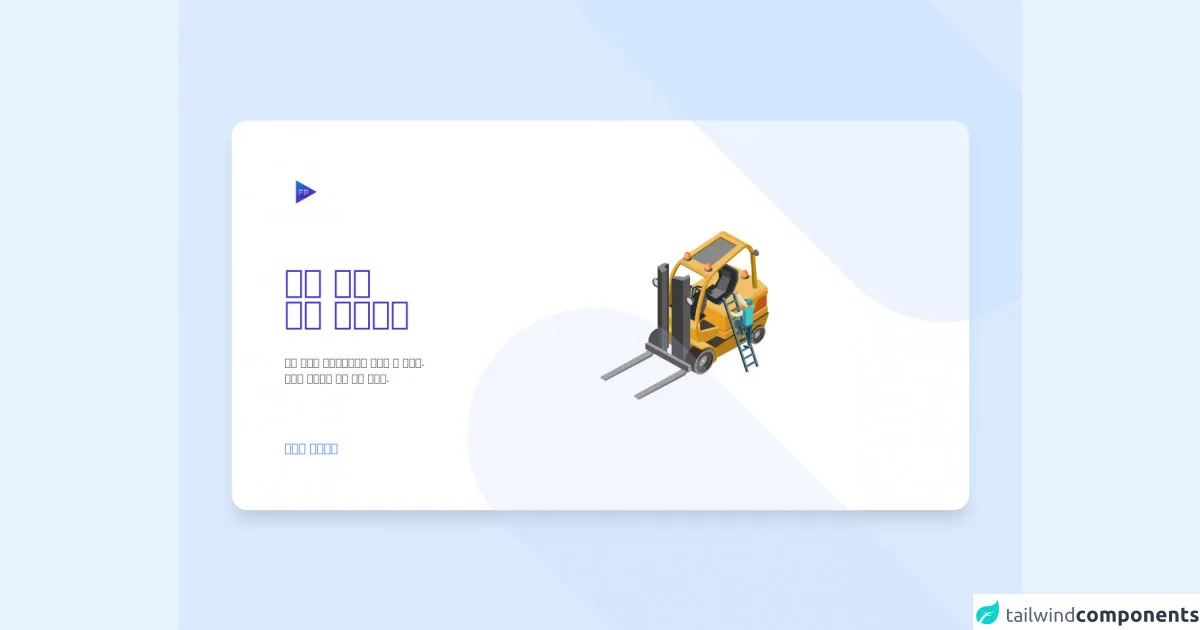- Published on
6 Easy Ways To Make A 404 Template (Fork) With Tailwind CSS

- What is Tailwind CSS?
- The description of 404 Template (Fork) ui component
- Why use Tailwind CSS to create a 404 Template (Fork) ui component?
- The preview of 404 Template (Fork) ui component
- The source code of 404 Template (Fork) ui component
- How to create a 404 Template (Fork) with Tailwind CSS?
- Step 1: Set up a new HTML file
- Step 2: Add Tailwind CSS
- Step 3: Add HTML code
- Step 4: Style the 404 Template (Fork)
- Step 5: Preview the 404 Template (Fork)
- Conclusion
As a FrontEnd technology blogger, I have come across many UI components that are essential for any website. One such component is the 404 Template (Fork) that is used when a user tries to access a page that does not exist. In this article, we will explore how to create a 404 Template (Fork) with Tailwind CSS.
What is Tailwind CSS?
Tailwind CSS is a utility-first CSS framework that provides pre-defined classes for common styles and layouts. It allows developers to quickly create custom designs without writing any CSS. Tailwind CSS is easy to learn and use, making it a popular choice among developers.
The description of 404 Template (Fork) ui component
A 404 Template (Fork) is a UI component that is displayed when a user tries to access a page that does not exist. It is an important component that helps users navigate back to the website's homepage or other relevant pages. The 404 Template (Fork) usually contains a message informing the user that the page they are looking for does not exist and a button to navigate back to the homepage.
Why use Tailwind CSS to create a 404 Template (Fork) ui component?
Tailwind CSS provides pre-defined classes for common styles and layouts, making it easy to create a 404 Template (Fork) UI component. With Tailwind CSS, developers can quickly create custom designs without writing any CSS. This saves time and effort, making it an ideal choice for creating UI components like the 404 Template (Fork).
The preview of 404 Template (Fork) ui component
To create a 404 Template (Fork) with Tailwind CSS, we will use the following HTML and CSS code:
<div class="flex flex-col items-center justify-center h-screen bg-gray-100">
<h1 class="text-6xl font-bold text-gray-800">404</h1>
<p class="text-2xl font-medium text-gray-800">Page Not Found</p>
<a href="/" class="mt-8 px-4 py-2 bg-blue-500 text-white rounded-md hover:bg-blue-600">Go back to homepage</a>
</div>
/* No custom CSS required */
Free download of the 404 Template (Fork)'s source code
The source code of 404 Template (Fork) ui component
To create a 404 Template (Fork) with Tailwind CSS, we will use the following HTML and CSS code:
<div class="flex flex-col items-center justify-center h-screen bg-gray-100">
<h1 class="text-6xl font-bold text-gray-800">404</h1>
<p class="text-2xl font-medium text-gray-800">Page Not Found</p>
<a href="/" class="mt-8 px-4 py-2 bg-blue-500 text-white rounded-md hover:bg-blue-600">Go back to homepage</a>
</div>
/* No custom CSS required */
<div
class="min-w-screen relative flex min-h-screen items-center overflow-hidden bg-blue-100 p-5 lg:p-20"
>
<div
class="relative min-h-full min-w-full flex-1 items-center rounded-3xl bg-white p-10 text-center text-gray-800 shadow-xl md:flex md:text-left lg:p-20"
>
<div class="w-full md:w-1/2">
<div class="mb-10 lg:mb-20">
<img src="https://flipstore.withun.link/identity/Group%201.svg" />
</div>
<div class="mb-10 font-light text-gray-600 md:mb-20">
<h1 class="mb-10 text-3xl font-black uppercase text-indigo-700 lg:text-5xl">
그런 앱은<br />없어 보이네요
</h1>
<p>찾고 계시는 어플리케이션이 없어진 것 같네요.</p>
<p>홈으로 돌아가서 다시 찾아 보세요.</p>
</div>
<div class="mb-20 md:mb-0">
<button
class="transform text-lg font-light text-blue-500 outline-none transition-all hover:scale-110 hover:text-blue-600 focus:outline-none"
>
홈으로 돌아가기
</button>
</div>
</div>
<div class="w-full text-center md:w-1/2">
<img src="https://flipstore.withun.link/images/404.png" class="h-64 w-64" />
</div>
</div>
<div
class="pointer-events-none absolute -top-64 right-20 h-96 w-64 -rotate-45 transform rounded-full bg-blue-200 bg-opacity-30 md:-top-96 md:right-32 md:h-full md:w-96"
></div>
<div
class="pointer-events-none absolute -bottom-96 right-64 h-full w-96 -rotate-45 transform rounded-full bg-indigo-200 bg-opacity-20"
></div>
</div>
How to create a 404 Template (Fork) with Tailwind CSS?
Now that we have seen the HTML and CSS code for the 404 Template (Fork), let's see how to create it step by step.
Step 1: Set up a new HTML file
Create a new HTML file and add the following code:
<!DOCTYPE html>
<html lang="en">
<head>
<meta charset="UTF-8">
<meta name="viewport" content="width=device-width, initial-scale=1.0">
<meta http-equiv="X-UA-Compatible" content="ie=edge">
<title>404 Template (Fork) with Tailwind CSS</title>
<link rel="stylesheet" href="https://cdn.jsdelivr.net/npm/[email protected]/dist/tailwind.min.css">
</head>
<body>
<div class="flex flex-col items-center justify-center h-screen bg-gray-100">
<h1 class="text-6xl font-bold text-gray-800">404</h1>
<p class="text-2xl font-medium text-gray-800">Page Not Found</p>
<a href="/" class="mt-8 px-4 py-2 bg-blue-500 text-white rounded-md hover:bg-blue-600">Go back to homepage</a>
</div>
</body>
</html>
Step 2: Add Tailwind CSS
Add the Tailwind CSS stylesheet to the HTML file. You can either download the CSS file or use a CDN. In this example, we will use a CDN.
<link rel="stylesheet" href="https://cdn.jsdelivr.net/npm/[email protected]/dist/tailwind.min.css">
Step 3: Add HTML code
Add the HTML code for the 404 Template (Fork) inside the body tag.
<div class="flex flex-col items-center justify-center h-screen bg-gray-100">
<h1 class="text-6xl font-bold text-gray-800">404</h1>
<p class="text-2xl font-medium text-gray-800">Page Not Found</p>
<a href="/" class="mt-8 px-4 py-2 bg-blue-500 text-white rounded-md hover:bg-blue-600">Go back to homepage</a>
</div>
Step 4: Style the 404 Template (Fork)
No custom CSS is required to style the 404 Template (Fork) as Tailwind CSS provides pre-defined classes for common styles and layouts.
Step 5: Preview the 404 Template (Fork)
Save the HTML file and open it in a web browser to preview the 404 Template (Fork).
Conclusion
In this article, we have explored how to create a 404 Template (Fork) with Tailwind CSS. We have seen that Tailwind CSS provides pre-defined classes for common styles and layouts, making it easy to create custom designs without writing any CSS. With these easy steps, you can create a beautiful and functional 404 Template (Fork) for your website.